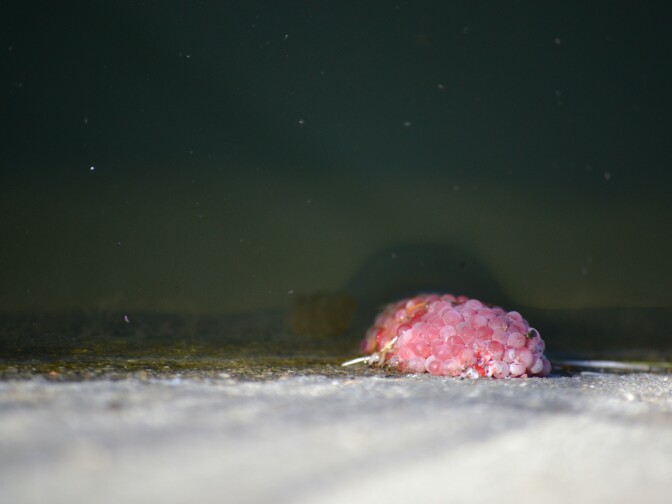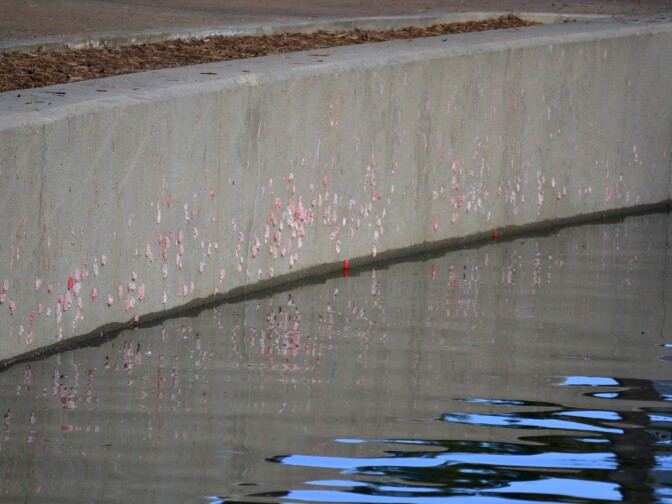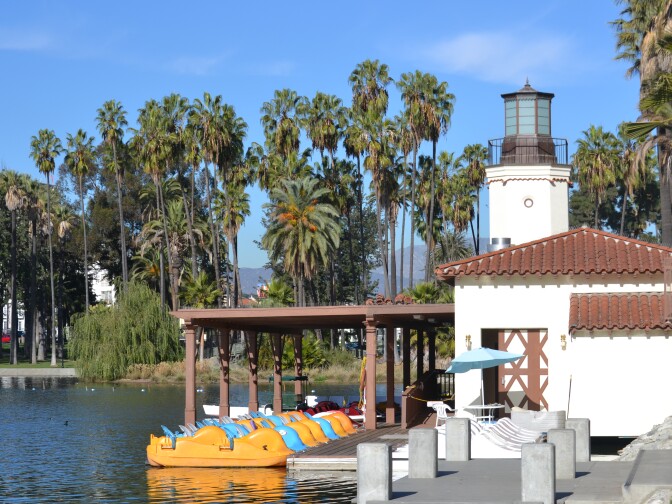Truth matters. Community matters. Your support makes both possible. LAist is one of the few places where news remains independent and free from political and corporate influence. Stand up for truth and for LAist. Make your year-end tax-deductible gift now.
This archival content was originally written for and published on KPCC.org. Keep in mind that links and images may no longer work — and references may be outdated.
New snail species invades renovated Echo Park
Visitors to the newly reopened Echo Park Lake may have noticed small, soft pink masses all over the walls of the lake and clinging to some of the plants in the water.
What are they? The mysterious pink blobs are little egg sacs belonging to a creature called pomacea canaliculata, more commonly known as the channeled apple snail, according to Lindsey Groves, collection manager of malacology—the study of mollusks—at the Los Angeles County Natural History Museum.
And that's a problem. The snails weren't there before the park just northwest of downtown Los Angeles got a major facelift last year. And with no natural enemies, there's nothing to keep them from multiplying.
RELATED: The lotus, the lake and the people are back at Echo Park Lake (Photos)
The 30-acre park reopened in June after a two-year, $45 million restoration project. L.A. voters approved the project in 2004 as part of Proposition O, a $500 million effort to clean up the city’s waterways.
“The [lake’s] filtration system was improved, the lotus bed was reinstalled, a lot of native plants and grasses were added to the perimeter of the lake,” said Javier Solis, principal grounds maintenance supervisor with the city’s Department of Recreation and Parks.
Solis said the park has been busier since it reopened, pointing out people riding paddle boats, kids enjoying the playground, and joggers circling the lake.
But since early autumn, park-goers have noticed snail eggs , which look something like chewed bubble-gum or large oblong raspberries, all over the park.
When full grown, the snails can be the size as a small apple. They spend most of their time underwater, and they lay a lot of bright pink eggs.
The surprising thing is apple snails weren’t living in Echo Park before the lake’s restoration. As far as Groves knows, this could be the first appearance of these snails in the L.A. area.
Native to South America
Apple snails are native to South America. And Groves says they’ve started showing up in other parts of the world because they’re popular aquarium pets.
No one seems to know exactly how the Apple snails made their way into Echo Park Lake. But it’s most likely that when the lake was drained and the wetlands were replanted during renovation, a few apple snails, or a few of their candy-colored eggs, were stuck to some of the new plants. Then, it wasn’t long before the lake was covered with them.
“Since they have no natural enemies here, they can reproduce quickly and that happens all the time with introduced species,” Groves said. “If there are any native species in the lake, [the apple snails] will out-compete them.”
The city’s pest control advisors recently started investigating the snails. They are now in the preliminary stages of deciding what to do about them. Filling the lake with pesticides would be risky, as would introducing another species to eat the snails. The snails could be fished out one by one, but as Groves put it, “there’s always the one you don’t get.”
Echo Park Lake is small, man-made reservoir. For the most part, it’s cut off from other waterways in L.A., but some of its water does drain into the L.A. River. So it’s not impossible that the snails could eventually start spreading to other parts of the city. Groves says the biggest concern about the apple snails is their appetite.
“They’ll eat pretty much anything you give them,” Groves said. He thinks it is likely that the snails will have a taste for the plants growing in Echo Park Lake — especially its signature lotus plants.
Established in 1892, Echo Park is one of the oldest parks in L.A. Lotus flowers have been blooming in the lake since at least the 1920s. The Park has also become known for its annual Lotus Festival, which was started in the 1970s.
In 2008, animal predators and dirty water were blamed for killing off all of the lotuses in the lake, though the actual cause of the plants’ demise was never pinpointed. During the park’s renovation, the entire lake was drained and the lotus beds were replanted.
Javier Solis said so far, the new lotuses have been thriving, “They didn’t think we were going to get very many flowers, but we got quite a bit actually, and they looked really good.”
Since the beginning of winter, the lotuses have wilted and the snails have been less active.
But come spring, when the plants start blooming again, we may find out just how big the apple snail’s appetite really is.












